Android Central Verdict
The Redmi Note 14 Pro+ builds on the strengths of its predecessor, delivering an elegant design that belies its price tag. The flowing curves combined with the vegan leather back and brand-new camera housing makes it one of the best-looking phones around, and it now comes with a massive 6200mAh battery that lasts two days between charges. You get one of the most versatile camera systems in this category thanks to a new telephoto lens alongside a decent wide-angle module, and the phone takes great photos. But there's a problem; the phone comes with Android 14 out of the box, there's plenty of bloatware, and the touted AI features aren't available at launch. Essentially, Xiaomi's continued software foibles ruin an otherwise great device.
Pros
- +
Gorgeous design
- +
Outstanding battery life
- +
Terrific cameras at the back
- +
Bright AMOLED panel
- +
More powerful than its predecessor
- +
IP68 ingress protection
Cons
- -
Doesn't come with Android 15 out of the box
- -
Still no 4K60 video
- -
Plenty of bloatware pre-installed
Why you can trust Android Central
I've always recommended Redmi Note devices in the past, and it was easy to do so; the devices combined great hardware with an unbeatable value, and they undercut their rivals by a considerable margin. But that hasn't been the case in the last two years, with Xiaomi changing focus to the mid-range category. While the Redmi Note 12 Pro+ and Redmi Note 13 Pro+ had gorgeous designs and decent hardware, they just didn't deliver on the value side of things, and the increase in price meant they didn't quite have the same mainstream likeability.
The Redmi Note 14 Pro+ is much the same; it costs just as much as its predecessor, but you get better cameras and powerful hardware. The battery life is where you'll see the biggest difference, with the device featuring a massive 6200mAh battery that easily lasts two days between charges.
However, Xiaomi hasn't done enough on the software side of things. The Redmi Note 14 Pro+ comes with Android 14 out of the box, and that just isn't good enough on a mid-range phone at the end of 2024. What's even more annoying is that the device will get just three Android OS updates, and Android 15 — which it should have launched with — counts as one.
While the hardware is arguably better, the software situation continues to be a real problem for Xiaomi, and the brand doesn't seem to care about it — at least not enough to do change its strategy.
Redmi Note 14 Pro+: Pricing and availability

Xiaomi unveiled the Redmi Note 14 series in Q3 2024, and the phones made their global debut in India on December 9. The Redmi Note 14 and 14 Pro are the affordable models in the series, with the Note 14 Pro+ delivering the best hardware and cameras.
The Redmi Note 14 Pro+ starts at ₹30,999 ($365) in India for the variant with 8GB of RAM and 128GB of storage, and the 8GB/256GB model costs ₹32,999 ($390). There's also a 12GB/512GB edition that's available for ₹35,999 ($425), and all three variants are available in all three color options — blue, black, and purple — so that's good to see.
Xiaomi accelerated the launch timeline in India, with the Redmi Note 14 Pro+ debuting a month earlier than its predecessor. There's no telling when the phone will be available in the U.K. and other global markets, but if I had to venture a guess, it'd be sometime in January.
Redmi Note 14 Pro+: Design
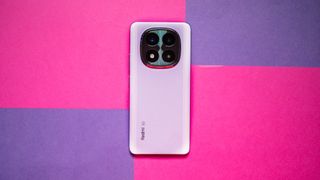
It's clear that design is a key area of focus for Xiaomi, and the Redmi Note 14 Pro+ is one of the best-looking devices in this category. In fact, I actually like this design more than that of the Xiaomi 14; the smooth curves makes the device look elegant, and you don't feel like you're using a mid-range phone.

The color I'm using is particularly great, as it has a vegan leather back — the other two models have a regular glass back instead. The leather finish feels great, and there's a stitched pattern that gives the phone a little extra character. There's a new camera island at the back as well, and like the rest of the design, it looks clean and elegant. This area is often an afterthought on most Xiaomi devices, so it's good to see the Redmi Note 14 Pro+ getting a module that accentuates the design.
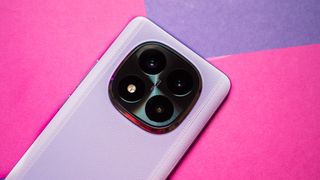
Xiaomi did the right things with material choices as well, with the device featuring an aluminum mid-frame that gives it additional rigidity. The sides have a glossy coat, and while you get symmetric curves, there's still enough width at the sides to hold the device. The sides are color-matched to the back, and again, it makes the device that a bit more upmarket.

The power and volume buttons have good tactility, and I didn't see any problems in this area. The only issue I have is that the in-screen module sits a little lower on the screen, making it awkward to access one-handed; this is true of the Find X8 Pro and several other devices I tested recently, so Xiaomi isn't the only brand doing this.
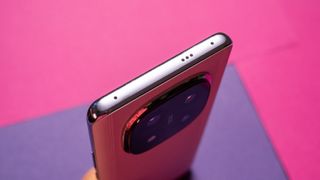
While the Redmi Note 14 Pro+ is 6g heavier than its predecessor, you get a significantly bigger 6200mAh battery. Honestly, I didn't notice the added heft, and Xiaomi did a good job with the weight distribution. The in-hand feel is similarly great, and the phone isn't bulky or unwieldy in the least.
The Redmi Note 14 Pro+ retains IP68 ingress protection as well, giving it added resilience against dust and water. Overall, Xiaomi did all the right things with the design of the Redmi Note 14 Pro+, and it doesn't end up looking like a mid-ranger.
Redmi Note 14 Pro+: Display

The Redmi Note 14 Pro+ uses the same 6.67-inch panel size as last year, but it gets much brighter, and it gets Gorilla Glass Victus 2 as standard. You get the usual 120Hz refresh and a resolution of 2712 x 1220, but Xiaomi uses the dynamic mode out of the box, so you'll need to go into the settings to enable 120Hz.
Xiaomi usually does a good job with color calibration, but my unit had cooler colors out of the box; thankfully, it's easy to adjust color balance via the settings. Other than that, I didn't notice any issues with the panel as such — it has good contrast and vibrancy.
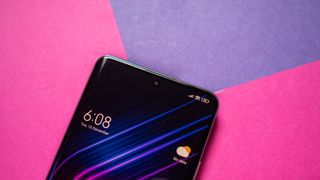
There are no problems using the panel outdoors; it gets sufficiently bright, and there's a slight difference from the Note 13 Pro+ in this regard. That said, the ambient brightness sensor is a little slow to adjust brightness, and I found myself having to use the brightness slider to manually adjust it several times.

While it won't win any awards, the Redmi Note 14 Pro+ holds up well during gaming, but you will notice jitter in demanding titles. Video streaming is good enough; there's HDR10+ and Dolby Vision, but switching to HDR content in YouTube made the video jittery at times. Outside of that, colors looked great, and there wasn't any excessive blooming.
Like previous years, you get stereo sound, and it's detailed enough that you can use the onboard audio if you're listening to a podcast. There's 1920Hz PWM dimming, and you get a decent amount of configurability when it comes to always-on styles.
Redmi Note 14 Pro+: Performance
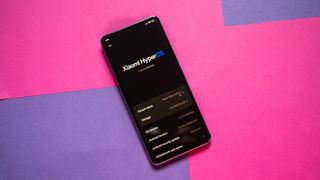
After using MediaTek-powered designs for the last three years, Xiaomi is back to using Qualcomm in the Redmi Note 14 Pro+. The phone is powered by the latest Snapdragon 7s Gen 3 platform, and it has a higher-clocked Adreno 710 and is manufactured on the 4nm node.
Given that Qualcomm was slow to switch to the latest Arm cores in the past, it's good to see the use of Cortex A720 and A520 cores this time. I noticed some lag at times — particularly when switching between a video and a game — but outside of that, there weren't any issues in regular use.
| Category | Redmi Note 14 Pro+ | POCO F6 | OnePlus Nord 4 |
|---|---|---|---|
| PCMark Work 3.0 (Overall) | 12359 | 15491 | 13396 |
| PCMark Work 3.0 (Web Browsing) | 12111 | 14944 | 12604 |
| PCMark Work 3.0 (Video Editing) | 7490 | 7691 | 7233 |
| PCMark Work 3.0 (Writing) | 14452 | 17327 | 13304 |
| PCMark Work 3.0 (Photo Editing) | 21036 | 26584 | 20533 |
| Geekbench 6 (single-core) | 1154 | 1762 | 1000 |
| Geekbench 6 (multi-core) | 3189 | 4608 | 3849 |
The phone does a good job with gaming as well, but it tends to be aggressive with thermal management, so you will see throttling in extended gaming sessions. There isn't much in the way of overheating, but you will see the occasional lag and jitter in demanding games; turning down the settings makes a difference.
Xiaomi is selling the Redmi Note 14 Pro+ in 8GB/128GB, 8GB/256GB, and 12GB/512GB configurations, and annoyingly, all storage modules of the device come with UFS 3.1 and not UFS 4.0. You miss out on Wi-Fi 6E as well, but there is Bluetooth 5.4 and NFC. I didn't see any issues with connectivity or calling, and I got a reliable cellular signal.
There's a new x-axis vibration motor, and while it doesn't deliver the same level of granular feedback as the Xiaomi 14, it is decent enough in its own right — considering how much you're paying for the phone.
Redmi Note 14 Pro+: Battery life
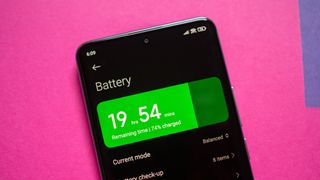
One of the best features of the Redmi Note 14 Pro+ is the significantly bigger 6200mAh battery. What's particularly great is that Xiaomi slotted in a silicon-carbon battery, so you get much better density, and the phone can withstand extreme cold without any issues. It's great to see brands bringing this tech to the mid-range segment.
The increased battery size gives the Redmi Note 14 Pro+ a distinct advantage, and the phone manages to last two days without any issues. Even with heavy use, I only had to charge the device every other day, so if you need a phone with the best battery life in this segment, the Redmi Note 14 Pro+ is the one to get.
You also get 90W charging, and Xiaomi bundles the requisite charger in the box. It takes just over 65 minutes to fully charge the device, and that's not bad considering the size of the battery. Xiaomi has the usual battery safeguards to extend longevity, including charging limit and optimized charging.
Redmi Note 14 Pro+: Cameras
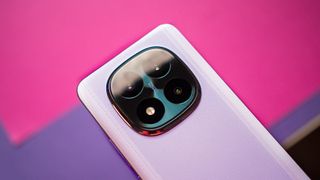
After using 200MP cameras, Xiaomi is once again back to a 50MP main camera on the Redmi Note 14 Pro+, and the device features OmniVision's OVX8000 module, dubbed the Light Hunter 800 by Xiaomi. This is the same sensor that's used in the POCO F6 Pro, Xiaomi 14 Civi, and even the Xiaomi Mix Flip, so the Redmi Note 14 Pro+ is in good company in this regard.
In a similar vein, Xiaomi added a 50MP Samsung JN1 telephoto lens at the back with 2.5x optical zoom, and this makes the phone much more versatile. After years and years of ineffectual auxiliary cameras, the Redmi Note 14 Pro+ gets usable auxiliary cameras, and the 8MP wide-angle lens is decent enough in its own right.
However, Xiaomi is yet to address long-standing issues with video recording on the Redmi Note series; the phone still doesn't get 4K60 video, and what's even more annoying is that it doesn't even have 60fps at 1080p when using the wide-angle lens. The camera interface itself is unchanged in four years, so if you've used a Xiaomi or POCO phone in the past, you'll be familiar with all the settings.










Thanks to the new sensor, the Redmi Note 14 Pro+ takes fantastic photos in any situation. Daylight shots have great detail and dynamic range, and accurate colors. You don't get overly saturated images, and foliage rendition is detailed without any aggressive smoothing. The camera does a fantastic job in low-light situations as well, providing good color vibrancy and plenty of detail, and no visible noise levels. It takes a smidgen longer to focus in low-light than high-end phones, but that's about the only shortcoming I noticed.
The telephotos lens is a good addition at the back, and it produces usable shots at up to 5x zoom. There's no OIS, and it may take a few tries to get the ideal shot, but again, the inclusion of a dedicated zoom lens is a big differentiator. The camera isn't quite as good in low-light, but you still get shots that are decent enough for sharing on social media. You get decent portraits as well, and while you can't adjust the focal length, there's a marked difference over the 13 Pro+.
The wide-angle lens is better than previous years, and while it doesn't measure up to the likes of the Xiaomi 14, it definitely holds its own against other mid-rangers. To sum up, the Redmi Note 14 Pro+ has a versatile camera system that takes great images in most conditions, and it is right up there with the best in this category.
Redmi Note 14 Pro+: Software
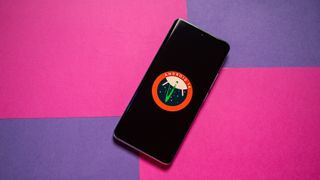
The Redmi Note 14 Pro+ comes with Android 14 out of the box, even though Google rolled out the stable version of Android nearly two months prior to the launch of the phone. Xiaomi's software interface needs an overhaul; the design is four years old at this point, and it's starting to show its age.
The UI has better fluidity than MIUI skins of yesteryear, and you get a decent amount of customizability. That said, ColorOS and Funtouch OS have better features in this area, and they're optimized much better. You also get plenty of bloatware, and while most of it can be uninstalled, it's annoying that Xiaomi hasn't addressed this yet.

Instead of delivering the latest Android version, Xiaomi focused its attention on AI-assisted utilities, and like every other phone today, the Redmi Note 14 Pro+ has a suite of AI tools with questionable usability. Circle to Search and AI-backed transcribing of audio recordings are useful, but I didn't see the utility of AI summaries and translate features baked into the Notes client.
Gallery has an AI-assisted object eraser, a tool that increases the size of the frame, and one that generates short video highlights from your photos. There's an AI translator and AI subtitles as well, and the main problem is that none of these are available out of the box — they'll be rolling out via software updates down the line. Given Xiaomi's track record at delivering timely updates, I wouldn't hold my breath.
Then there's the issue with system updates. Xiaomi is guaranteeing three Android OS updates and four years of security updates, but the problem is that Android 15 counts towards one of those updates, and that's just an underhanded move. Xiaomi does this intentionally so it doesn't have to bother with long-term updates down the line, and this practice alone makes me not want to recommend the device.
Redmi Note 14 Pro+: The competition

The POCO F6 is my go-to recommendation in this segment, with the device offering a terrific combination of hardware and battery life. The camera isn't as good as the Redmi Note 14 Pro+, but it comes close, and it does a much better job at gaming. The battery lasts a day and a half, and coming in at ₹29,999 ($353), you get a much better value.
Obviously, the OnePlus 12R continues to be a terrific choice, and while it is costlier at ₹35,999 ($425), you get a better phone in just about every area. The AMOLED panel gets brighter, the phone is significantly faster in regular use, and the main camera takes better photos in just about any scenario.
Nothing's Phone 2a Plus is also an intriguing choice to consider. It has a distinctive design, great software features, and two usable cameras at the back. And starting at ₹26,999 ($318), you're not paying a hefty premium.
Redmi Note 14 Pro+: Should you buy it?
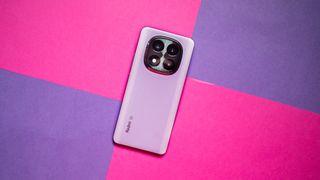
You should buy this if:
- You need a good-looking mid-range phone
- You want great cameras at the back
- You need the best battery life in this category
You shouldn't buy this if:
- You want good software with meaningful extras
- You need long-term updates
- You want a phone that takes good videos
I tested every Redmi Note phone released in the last decade, so I know what I'm talking about when it comes to these devices. While the Redmi Note 14 Pro+ is costlier than earlier phones that came in the series, there isn't a price hike this year, and that's a good thing.
The hardware is really rather good, and the cameras are great — the inclusion of a telephoto lens gives it a decent edge, and that's no small feat in this category. The battery life is easily the best I've used on any mid-ranger, and it doesn't take long to charge the battery either.
But like the last two years, it's the software that ultimately limits the device. If you don't have an issue with the fact that the phone comes with Android 14 out of the box, then yes, the Redmi Note Pro 14+ is a decent choice. But the software makes a bigger difference in how long you can actually the phone, and in this area, Xiaomi is once again found to be lacking.
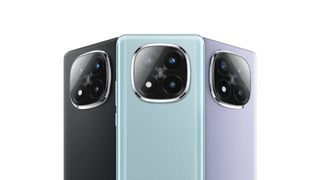
The Redmi Note 14 Pro+ combines terrific cameras with a massive battery, and the phone clearly nails the basics. However, the software is middling at best, and it detracts from what is an otherwise great device. If you don't mind that and need great cameras and two-day battery, the Redmi Note 14 Pro+ is a good overall choice.

Harish Jonnalagadda is Android Central's Senior Editor of Asia. In his current role, he oversees the site's coverage of Chinese phone brands, networking products, and AV gear. He has been testing phones for over a decade, and has extensive experience in mobile hardware and the global semiconductor industry. Contact him on Twitter at @chunkynerd.
-
spacerays86 Wow no 1080p60 on ultrawide, note 10 pro can do that. Also same mistake over and over again : no microsd and headphone jack.Reply
